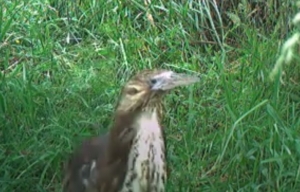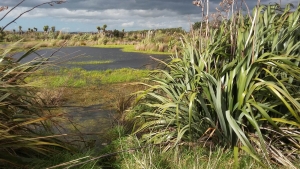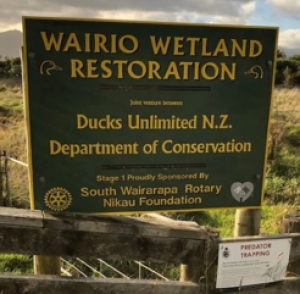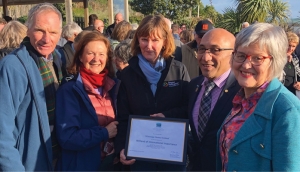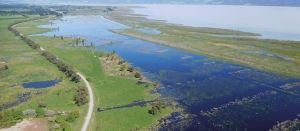Displaying items by tag: Wairio
Elusive Bittern
Elusive Bittern caught on camera at Wairio Wetland
Jessica Wagner is a student at Victoria University of Wellington, researching rat response to scent and acoustic stimuli in the Wairio wetland. The intended outcome of Jessica's research is to determine what stimuli are most attractive to rats in order to improve trapping efforts, and ultimately, to protect rare birds such as the Bittern and wetlands in general.
Jessica was a recipient of one of the wetland care scholarships.
"I was recently going through my footage and noticed that one of my cameras has recorded a video of a Bittern on the 4th of December! I thought that you and others at Ducks Unlimited NZ may be interested in this so I have attached the video below. Feel free to share with anyone else who may be interested" (Jessica) .
Research scholarships aid restoration
Research scholarships aid restoration of native wetlands
Thanks to Wetland Care Research Scholarships funded by Ducks Unlimited, our student researchers are finding the best ways to recreate a haven for waterfowl.
Wetlands in Aotearoa New Zealand are precious natural resources viewed as taonga by Māori, which provide a habitat for fish and birds.
Even in purely financial terms, wetlands are valuable for their role in filtering nutrients from water, absorbing carbon, and controlling erosion and flooding.
Sadly, they are now in crisis. With over 90% of our wetlands lost over the past 100 years, many plants and animals are struggling for survival, including the elusive matuku (Australasian bittern) and pūweto (spotless crake).
Purple Loosestrife - pretty enemy
Help spot purple enemy at Lake Wairarapa
2022 Wairarapa Moana annual spring matuku and spotless crake survey
First recorded booming within the DU Wairio wetland
The spring 2022 survey report compiled by Shane Cotter, a contractor engaged by GWRC.
John Cheyne of Wetlands Works led annual spring surveys for Australasian bittern (matuku, Botaurus poiciloptilus) and spotless crake (pūweto, Zapornia tabuensis) at selected wetlands within Wairarapa Moana between 2012 and 2021. In 2022, John passed this responsibility to me. I conducted the annual spring (October-November) 2022 survey using the same methodology as in previous years so continued comparisons could be made of the annual results.
This year’s survey focused on the core wetlands (Boggy Pond, Matthew’s Lagoon and Wairio wetland) and the northern wetlands (Barton’s Lagoon, Tauherenikau delta, Simmond’s Lagoon, JK Donald Block). Only booming male matuku are surveyed because females are much less vocal and therefore very difficult to detect and monitor. This booming call is associated with males attempting to attract females for breeding. Pūweto were also surveyed at Boggy Pond and Matthew’s Lagoon.
In the 2022 survey, 11 booming male matuku were located at the core wetlands and 12 in the northern wetlands. This is an increase in previous years and a record number at both locations. At the core wetlands, numbers have remained relatively stable at 8-9 birds since 2014 while at the northern wetlands, annual numbers of male matuku has varied between 3-9 birds. Overall, the combined number of booming male matuku at the core and northern wetlands has steadily increased from 10 in 2016, to 16 in 2018, to 18 in 2020, and now 23 birds in 2022. In addition to the 23 male matuku heard booming during the 2022 survey, three other birds were seen, one in Matthew’s Lagoon near Boggy Pond and two in Wairio wetland.
At Boggy Pond, nine pūweto were located, the most in Boggy Pond since 2018 and significantly up on the single individual in 2021. At Matthew’s Lagoon, none were recorded during the kayak survey which has been a regular result there since 2014. While undertaking the matuku survey, four other pūweto were heard calling independently, not in response to playback calls. Two were calling in Matthew’s Lagoon close to each other while at two locations within Wairio wetland, one individual was heard calling. I believe there are more pūweto present than recorded during the pūweto surveys. They have just moved to different areas of the wetland complex outside the pūweto survey routes seeking more suitable habitat.
On-going predator trapping with the regular servicing of traps is essential as several predators were seen dead in traps within days of the traps being serviced and rebaited with fresh bait by the trapping contractor at the core wetlands. These included a weasel and several rats. All traps observed were well set up and maintained, and had good vegetation clearance.
Follow the 'read more' link to view the survey report.
Wairio on show
About 30 people braved squally rain on Sunday, May 9, for a guided tour of Wairio Wetland led by Ducks Unlimited NZ President Ross Cottle and Director Jim Law.
The event was a Rural Women New Zealand annual event to raise money for the Associated Country Women of the World to help fund community projects in developing countries.
Before setting out, Ross and Jim told the visitors about DU’s long involvement with the wetland – from Stage 1, its initial project about 17 years ago through to the latest development in Stage 4.
Ross said the wetland’s only water source in 2005 was courtesy of high wind dumping water into it from Lake Wairarapa to the west, but it didn’t retain it, and the water flowed straight back into the lake.
DU put in a bund wall, which was moderately successful, holding the water through the bird breeding season, but by December, it had dried out.
The next step was to dig down to a lower level to keep the water there longer, which was more successful, holding the water till the birds had bred and fledged. At the same time, DU planted out native species and these are now well established in Stage 1.
From there, it was on to Stage 2 and 3, and every low spot was fenced off with a bund wall.
Stage 3 was handed over to Victoria University because “we wanted some science behind it”, Ross said. It was envisaged that the project would provide a template for wetland restoration.
“Next thing, someone had a bright idea to put in a bund wall” between the three stages and the lake. About two weeks later, a mighty wind blew water in from the lake and “we had 100 acres of water”. After that success, DU extended the bund all the way back to Stage 1.
This was “amazingly successful” and has created a wetland of more than 250 acres of water.
“We were successful beyond our wildest dreams,” Ross said.
Jim said Wairio had been a ground- breaking project, with the Department of Conservation handing over the wetland’s management to DU – at the time it was unheard of for DOC to hand over restoration of its land to a local group.
“It only took us two years to convince DOC to let us spend our money on their land.”
DU has spent more than $200,000 in the past 17 years. About half of this has come from donations, which began rolling in once people saw how Wairio was being transformed and the return of wildlife.
On the 4.2km walk, Jim led the visitors along the bund wall track through Stage 4 of the wetland, where he described DU’s vision of the future – when stands of kahikatea would replace the current open areas of fescue.
With a rainbow in the background, and Ross bringing up the rear in his side-by-side to assist any stragglers, the tour covered Stages 3 and 2 before reaching its conclusion at Stage 1.
On a small detour from the main track to the water’s edge at Stage 4, the group had a preview of the proposed site for a viewing hide which DU has built. It is now waiting for a resource consent to place it on the site.
Birdlife has flourished at Wairio since DU took over, and the number of royal spoonbills, which previously had not been seen for 30 years, have surpassed 100, and they are breeding there.
Bittern numbers have remained stable in the past four or five years, despite a continuing decline throughout the rest of New Zealand.
Over a hot cuppa back at the cars, the visitors said the tour had been a revelation and they were highly impressed with their tour guides’ continuing passion and enthusiasm for the project.
Wairio Wetlands Guided walk-through
Sunday 9 May 2021 at 12.30pm
Rural Women NZ Martinborough invite you to join them on a guided walk through
the Wairio Wetlands on the eastern shore of Lake Wairarapa.
4.2 km one-way, round trip 7 km. Return transport provided if required.
Witness the 15 year restoration programme led by Ducks Unlimited NZ.
Good walking track, sensible footwear required but unfortunately not suitable for wheelchairs.
No toilet facilities available. No dogs allowed. Will go ahead rain or shine.
Directions: From Kahutara Road turn on to Parera Road and continue for approximately 2.6 km.
The gathering point will be clearly indicated.
Cost is $5.00 per person, with all funds to support Associated Country Women of the World,
to assist with community projects in developing countries.
Contact: Marilyn Law 027 2239354 or Viv Malneek 027 5358805 if further information required.

Ramsar status for Wairio
Wairarapa Moana, which includes the Wairio wetland, has been recognised as a wetland of international importance under the Ramsar Wetland Convention.
Wairio has been Ducks Unlimited’s most significant, and its most rewarding, project over the past 15 years.
Conservation Minister Eugenie Sage, in announcing Ramsar’s decision at a ceremony at Lake Onoke on August 21, congratulated all the partners involved, including Ducks Unlimited.
Explore the Wairarapa Moana
Nationally Recognised restoration efforts
According to WaiWetlands, you should prepare to be inspired by nationally recognised restoration efforts at Wairio by community group Ducks Unlimited.
Once a paradise for waterfowl and aquatic species, the wetlands were greatly affected by drainage schemes in the twentieth century. Today they are a living example of what is possible through wetland restoration efforts.
Go to the Wairarapa Moana Wetlands website and read the whole story
Planting day at Wairio
A planting day for Victoria University students and Ducks Unlimited members at Wairio came with a few more mod cons than usual, thanks to DU President Ross Cottle.
He arrived in his motorhome with Big Red, the side-by-side in tow, which meant hot cups of tea and sausages for lunch and the easy delivery via SxS of the plants to the planting site.
There was a good turnout as students from Victoria University’s School of Biological Sciences led by Stephen Hartley, director, Greater Wellington Regional Council and DOC representatives, DU members and others all chipped to help with the day’s work.
About 300 specimen trees – kahikatea, tōtara, swamp maire and cabbage trees – were bought with a $2000 grant from the Department of Conservation.
Many hands make light work, and by the end of the day, the trees were in place as in-fill in Stage 3 of the wetland, the university’s “classroom in a wetland”, among the nursery trees planted five years ago.
AGM Conference and reports
This year’s Ducks Unlimited New Zealand’s 45th conference was held at the Collegiate Motor Inn in Whanganui, with just over 50 attendees. The weather was kind and, after a bitterly cold, wet and windy Friday, turned on the sunshine in time for the field trip on Saturday, 3 August.
President Ross Cottle opened proceedings at the AGM by saying it had been a reasonably quiet year, with only three members’ wetlands being developed, however work at Wairio Wetland was going well and good progress had been made.
He paid tribute to long-time DU supporter and Wairarapa Chapter Secretary/Treasurer Joyce Brooks who passed away shortly after the previous AGM.
Treasurer John Bishop, after his traditional warm-up joke, presented his report. He confirmed and reviewed the requirements of being a charitable trust, which include providing a mission statement, entity structure and a yearly report of income, expenditure, activities and volunteer support.
The information for the Charities Register notes DU is reliant on volunteers, with about 8000 volunteer hours a year spent on wetlands assessment and building, swan collection, and advice, education, field days, bittern project, supplying magazine content, Wairio planting and education, supporting schools, fundraising, auctions and dinners.
After running through the financials, which show a slight deficit for the year, John concluded:
“We are remain solvent, through support from membership subscriptions, auctions, grants from the Wetland Care Trust, and donations from Treadwells, Pharazyn Trust, Muter Trust, South Wairarapa Rotary and one-off grants.”
Election of Officers
The DU Board remained unchanged, with the two directors whose two-year terms were up, Jim Law and John Dermer, being re-elected unanimously.
Waterfowl and Wetland Trust
David Smith reported that the trust was in good shape thanks to the sharemarket, and despite paying out $40,000 to DU, was in a similar financial position as it was at the end of 2017.
He said the trust was doing exactly what it was set up to do: provide money to enable DU to carry on its work.
Wetland Care
Will Abel said that in line with the previous couple of years, there had been few applications for new projects, with most of the wetland creation activities centred on the Wairio Wetland.
A large wetland in Pahiatua that DU committed $5000 to three years ago had been completed, and in Masterton, DU had helped created another large wetland, to which it contributed $4000.
Royal Swan
Will Abel said it had been a disastrous year for the royal swan, with no cygnets available and even the wildlife centre at Peacock Springs, Canterbury, the usual source of swans, was looking for some new breeding stock.
“We have no idea why really, but anecdotally I suspect it is because it coincides with the 50th anniversary of the moon landing,” he said, tongue in cheek.
“If it improves next year, my supposition will be proved correct, and I will present a paper at the next conference on it.”
He said it was fortunate that there had not been many requests for swans.
Whio
Peter Russell reported that the breeding programme had had a good season, with 65 whio reared from captive pairs and 15 reared from wild clutches. A total of 72 were released.
In the North Island, 30 were released. Three older birds from last season were released on the Whakapapanui in December, and 12 birds, six males and six females, were released at Blue Duck Station in January.
The third release, on the Manganui a-te-Ao, was in early March, with eight males released at the Ruatiti Domain and four females released down the river where there was a surplus of males. Three male birds were released on Mangawhero stream on 20 March.
Peter said it was always a great thrill to take part in the releases out on the river. He has been doing them since 1997 and it has changed so much. In 2000 they released seven, compared with 72 in the past year.
In the South Island, 20 birds were released on the West Coast in January in the Wainihinihi, Arahura, Styx and Kawhake rivers; 12 birds were released on the Taipo River in March; in Tasman 10 birds were released.
Membership
Paul Mason reported that DU currently had 280 members, with 57 of those unpaid as at the AGM.
He said a second subs reminder would be sent out, following email and postal reminders subsequent to the initial subs mailout.
He noted that in the past three years, payment preferences were moving from cheque to internet banking. Credit card payments remained about the same and PayPal transactions were increasing.
More members were responding to the suggestion that DU communicated with them more by email, he said.
Website
Paul said new articles were added as events occur, with the most recent being the planting day at Wairio Wetland. Flight magazines, from No 155 to the current issue, have been loaded on to the site. Issue 29 has also been scanned and added as a PDF file.
Articles from more recent Flight magazines are being transcribed and loaded as searchable items – so far back to issue 159. Old issues are being scanned and loaded as PDFs.
He noted a drop-off in website visitors in the past three months and in response had upgraded the site-mapping software and re-registered the site with search engines.
The main files being downloaded were Flight magazines and people were also accessing the educational resources files (from Quack Club), he said.
Wairio Wetland
Jim Law reported that the wetland was in good heart, benefiting from continued restoration work, albeit at a more modest cost to DU ($4455 versus $9500 in the prior year). Work focused on more bund wall improvements ($1700), tree planting ($2000) and noxious plant control ($755).
At last, significant progress was made by the Greater Wellington Regional Council to reticulate water from Matthews Lagoon and Boggy Pond to Wairio. Earthworks have been completed but after a “weather event”, remedial work is required. This will be done this summer.
“We had provisionally budgeted to fund a portion of this work but GWRC assumed full responsibility,” he said.
Total expenditure by the Wairio Restoration Committee, not counting volunteer time, since inception 14 years ago, now stands at $220,000.
The Victoria University of Wellington School for Biodiversity and Restoration Ecology remain focused on their research at Stage 3.
The Restoration Committee is still holding funds (lodged with DU) from fundraising efforts totalling $10,807. A further $15,000 grant was recently received by local donors. These funds are also being held by DU on behalf of the project committee.
As mentioned last year, Wairarapa Moana, which includes the Wairio Wetland (administered by DOC on behalf of the Crown), has been included in a Treaty of Waitangi settlement with Wairarapa iwi. “Whilst the settlement has been delayed, the local iwi has assured us that they want us to continue our good work restoring the Wairio Wetland.
“We remain of the view, though perhaps slightly biased, that DU members should be proud of this project,” Jim said.
Scholarships
Jim Law reported on DU’s new initiative offering scholarships to students doing research in a relevant area. A trial offering a total of $25,000 over three years in grants of $5000 per student so far had had little response to date.
Four universities had been approached and it was likely the first recipient of one of the $5000 grants would come from Victoria University working on the Wairio site.

